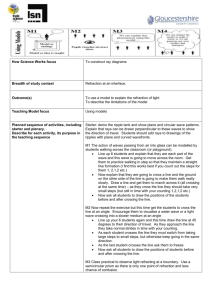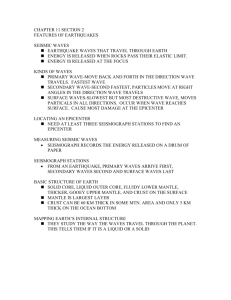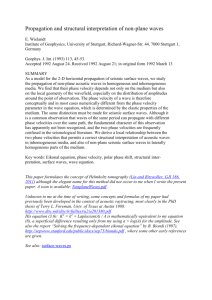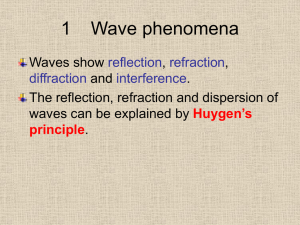ppt
advertisement
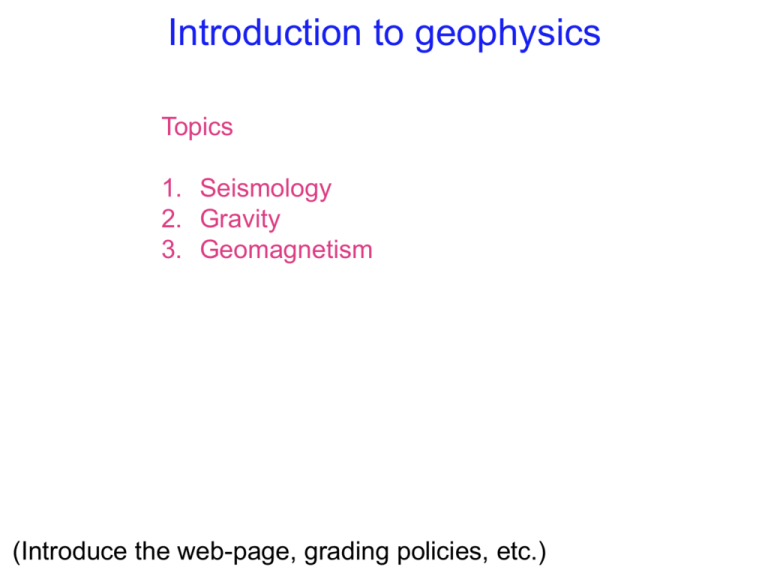
Introduction to geophysics Topics 1. Seismology 2. Gravity 3. Geomagnetism (Introduce the web-page, grading policies, etc.) Seismic Rays and Snell's Law: Reminder of waves: Wavelength, Frequency, f Period, T=1/f Velocity, V=f Wavefront When a sudden stress is applied (or released), the corresponding strain propagates out from the source in the form of waves. 2D waveforms are lines (surfaces in 3D) that connect points of equal travel times. Schematically illustrated wavefronts: Numerically simulated wavefronts: Huygen’s principle This is a geometrical construction that tells us how wavefronts will move (but not why). It states: “Every point on a wavefront acts as a source of spherical secondary wavelets such that after some time dT the primary wavefront lies on the envelope defined by all the secondary wavelets. The radius of the secondary wavelets will be V dT, where V is the wave speed. (Note: the principle is deficient in that it fails to account for the directionality of the wave propagation in time, i.e., it doesn't explain why the wavefront at time T + dT in the above figure is the upper rather than the lower envelope of the secondary wavelets. Why does an expanding spherical wave continue to expand outward from its source, rather than reconverging inward back toward the source?) There are different types of wavefronts Body Waves: P-wave - P stands for ''Primary'' or ''Pressure'’. - Particles undergo coaxial volume change. - Similar to sound waves traveling through air. Animation courtesy of Dr. Dan Russell, Kettering University Body Waves: S-wave - P stands for '’Secondary'' or '’Shear'’. - Particles undergo non-coaxial with no volume change. Animation courtesy of Dr. Dan Russell, Kettering University Typical propagation velocities of various materials: P and S - velocities are a function of the rock density, , and it's elastic modulus, C: V (why elasticity?) C Hook’s law (highly simplified): stress elastic modulus strain Shear modulus (or rigidity): shear stress shear strain Bulk modulus: K pressure volume change P-velocity: S-Velocity: VP K 4 3 VS • VP>VS (since both bulk and shear modulus are positive). • For liquids and gases =0, therefore VS=0, and VP is reduced. • P and S velocities are reduced if the rock is fractured of porous. Given that: elastic constant V density how does body waves vary with depth? Preliminary Reference Earth Model (PREM): Seismic velocities of denser rocks are higher, since the elastic moduli K and are also dependent on density. Surface waves: Reyleigh waves: Love: Animation courtesy of Dr. Dan Russell, Kettering University •Surface wave velocities are slower than body wave velocities. •Surface waves are more destructive. A few seismograms: Local: Note that the amplitude of the surface waves is greater than that of the body waves. Teleseismic Note that the P-wave is more visible in the vertical component. On the other hand, the S-wave is clearly more visible in the horizontal components. Sesimic waves and seismic rays A wave front is a surface connecting all points of equal travel time from the source. Rays are normal to the wavefront, and they point in the direction of wave propagation. While the mathematical description of the wavefronts is rather complex, that of the rays is simple. For many applications is it convenient to consider rays rather than wavefronts. Fermat’s principle and Snell’s law: According to Fermat’s principle, a wave propagating from point P to Q follows a path of minimum time. P 1 2 Q What path will take a ray from P to Q? The travel time from P to Q is: TPQ d e a2 x 2 b 2 (c x) 2 V1 V2 V1 V2 Since the wave speed in each layer is constant, the ray path is completely defined by the position of P, Q and the point where the ray crosses the interface. Since this is a path for which the traveltime is minimum: dTPQ x cx 0 dx V1 a2 x 2 V2 b2 (c x) 2 Note that: x a x 2 2 sin( 1) and cx b (c x) 2 2 sin( 2 ) Thus we get Snell’s law: Sin(1) Sin(2 ) P C1 C2 P is called the ray parameter. Even in a multilayered or a highly heterogeneous medias, the ray parameter remains constant along the ray path Snell’s law Just as in optics The angle of reflection equals the angle of incidence, and the angle of refraction is related through the velocity ratio: incoming reflected sin( air ) sin( air ) sin( glass Vair Vair Vglass refracted ) P Seismic rays too obey Snell's law. But conversions from P to S and vice versa can also occur. Extended form of Snell’s law The incidence angle of the reflected and transmitted waves are controlled by an extended form of the Snell's law: sin i 1 sin 1 sin i sin P 2 2 Sesimic waves and seismic rays It is important to understand that the two approaches are not exactly equivalent. Consider a planar wavefront passing through a slow anomaly. Can this anomaly be detected by a seismic network located on the opposite side? With increasing distance from the anomaly, the wavefronts undergo healing. This effect is often referred to as the Wavefront Healing. QuickTime™ and a Compact Video decompressor are needed to see this picture. On the other hand, according to the ray theory the travel time from point A to B is given by: T B A B A 1 dS C(S) where dS is the distance measured along the ray, and C is the seismic velocity. Thus, a ray traveling through a slow anomaly will arrive after a ray traveling through the rest of the medium.





